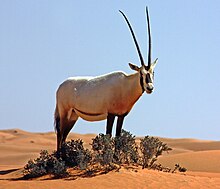Wildlife of Qatar

The wildlife of
Fauna
Mammals

There are 21 species of mammals in Qatar.[2] Larger terrestrial mammals such as the Arabian oryx and Arabian gazelle are protected and are held in nature reserves.[3] The Arabian gazelle is the only native gazelle species to Qatar and is locally referred to as the rheem.[4]
Qatar's largest mammal is the dugong. Large numbers of dugong appear north of the peninsula's shores.[5] Qatari waters accommodate one of the largest concentrations of dugong in the world.[6] Two species of fox appear in the country. Sand cats also occur in the desert, and sometimes take over abandoned fox dens. Honey badgers (also known as ratel) appear primarily in the southwest of the peninsula.[7] Golden jackals, a species which was previously thought to have been extirpated in the 1950s, was re-discovered in 2008 in Ras Abrouq.[8] Two species of bat are found in the country: the trident bat and the desert long-eared bat. The former is more common.[9] Qatar has the highest density of camels in the Middle East.[10]
Birds

There are 215 common birds in Qatar.
The Arabian ostrich went extinct in 1945. The North African ostrich was introduced in the later 20th century and is now concentrated in Ras Abrouq.[13]
Reptiles

Fish
There are at least 500 fish species in Qatar.[17] The northeastern coast has the highest density of fish. Fish caught in the aforementioned region include Carangidae, Pomadasidae, Lethrinidae and Lutjanidae.[18]
Invertebrates

Penaeus is by far the most abundant genus of prawn in the peninsula. Other crustaceans, such as Metapenaeus elegans, Metapenaeus stebbingi, Metapenaeus stridulands, and slipper lobsters have been documented.[19]
There are more than two-hundred
At least 170 species of insects belonging to 15 orders exist in Qatar. These include
Flora

More than 300 species of wild plants are present in the peninsula.
Shallow depressions referred to as rodat constitute a more varied selection of plants since rainwater run off is more easily accumulated.
Protection of endangered species
Qatar is committed to protecting endangered wildlife species, as highlighted by the Ministry of Municipality and Environment (MME). One of the key initiatives includes the protection of
The Ministry of Environment and Climate Change has undertaken various programs and projects to preserve wildlife and biodiversity. Notable efforts include the lizard biodiversity conservation project, which has monitored 21 lizard species, and breeding programs for endangered animals such as the Arabian oryx, sand gazelle, ostrich, bustard, and wild rabbit. Additionally, Qatar has made significant strides in sea turtle protection along all its coasts since 2002 and has implemented a project to study and propagate mangrove plants along the coast, aiming to extend their presence to new areas.[27]
See also
External links
References
- ISBN 9780907151500.
- ^ "Mammals database". Qatar e-nature. Retrieved 21 February 2019.
- ^ a b Casey & Vine 1992, p. 103
- ^ "Arabian Goitered Gazelle (Reem)". Al Waabra Wildlife Preservation. Retrieved 13 May 2015.
- ^ Casey & Vine 1992, p. 104
- ^ "Human 'activities threaten local dugongs'". The Peninsula. 1 December 2015. Retrieved 1 December 2015.
- ^ a b Frances Gillespie (27 September 2010). "Qatar Wildlife". Oryx in-flight magazine. Retrieved 13 May 2015.
- ^ "Golden Jackal in Qatar". Tribulus. 1 January 2009. Archived from the original on 24 September 2015. Retrieved 13 May 2015.
- ^ Casey & Vine 1992, p. 105
- ^ Richer R, Al-Hemaidi A. (2013). "On the presence and distribution of the Gulf sand gecko, Pseudoceramodactylus khobarensis Haas, 1957 (Reptilia: Squamata: Gekkonidae) in Qatar". QScience Connect
- ^ "Book sheds light on 215 common birds of Qatar". The Peninsula Qatar. 8 January 2011. Retrieved 13 May 2015.
- ^ a b c d Casey & Vine 1992, p. 89
- ^ "Ostrich". Oiseaux Birds. Retrieved 14 May 2015.
- ^ Casey & Vine 1992, p. 94
- PMID 24493961. Retrieved 13 May 2015.
- ^ "The "Wild" Night Life of Qatar". Helen Ziegler & Associates. Retrieved 14 May 2015.
- ^ "List of Marine Fishes reported from Qatar".
- ^ a b Casey & Vine 1992, pp. 96–97
- ^ Casey & Vine 1992, p. 101
- ^ Casey & Vine 1992, p. 102
- . Retrieved 14 May 2015.
- ^ M, Abdu R (1985). "A Preliminary List Of The Insect Fauna Of Qatar" (PDF). Qatar University Science Journal.
- ^ a b Casey & Vine 1992, p. 77
- ^ "Samr". Qatar e-nature. Retrieved 14 May 2015.
- ^ a b Casey & Vine 1992, p. 78
- ^ Tribune, Qatar; webmaster (2019-05-26). "Qatar committed to protecting endangered wildlife species: MME". Qatar Tribune. Retrieved 2024-02-19.
- ^ Newspaper, The Peninsula (2024-01-01). "Ministry of Environment reviews efforts to conserve wildlife". thepeninsulaqatar.com. Retrieved 2024-02-19.
